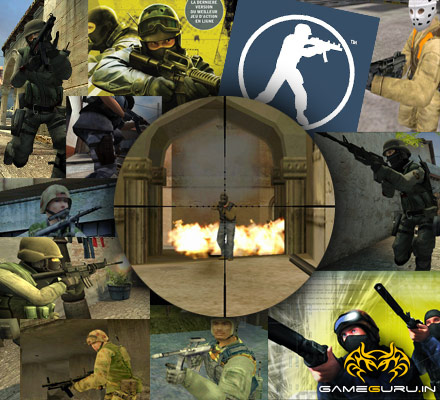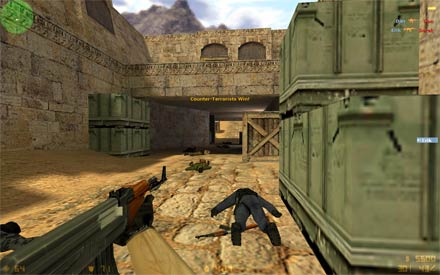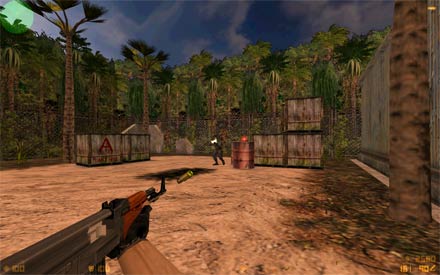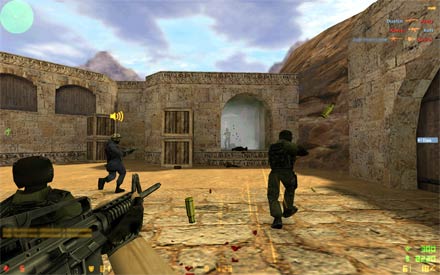Walking into a video game parlor in sub-urban Mumbai in India, it’s not uncommon to hear the simultaneous roars of “Fire in the Hole”, “Damn it… I’m dead”, and the hurling of abuses back and forth. All of us have probably been bang in the middle of a scene just like this at one time or another while playing the now legendary game of Counter-Strike. Make no mistake, we’ve enjoyed every tense moment of it.

Beginnings:
Counter-Strike has very humble origins. Released on June 18, 1999 it actually began as a modification of the very popular Half-Life Series. The game’s earlier multiplayer versions were not as popular, but that changed when developer, Valve, released Software Development Kits. This gave the creator Minh Le, also known as Gooseman on the internet, all the tools he needed to do the modeling, skinning, and animation for the game, along with the coding. His partner Jeff Cliffe handled more of the online PR part, but ended up contributing a lot to the overall development of CS. The maps were handled by outside parties interested in the mod and not by Minh Le, which meant that the game’s development team was two people with contributors making the maps. The first official version was released on November of 2000. It was called CS 1.0, and at this stage Valve took over the development and released the first standalone version, Half-Life: Counter-Strike, or CS Retail as it came to be known. CS Retail did not need Half-Life to run. It was a standalone multiplayer game with a host of user-generated mods available online. The team steadily built up on the first version making constant improvements on the gameplay. These improvements resulted in the release of versions 1.1, to 1.5 and finally the game that is still played by millions to this date CS 1.6.
Graphics:
The graphics are based on the HL1 engine made for computers in 1998. Though there have been steady improvements in the subsequent versions of CS, the graphics have not changed much. But then again, it isn’t the graphics that have made this game a hit, which is apparent since a fairly large number of people still play it just as enthusiastically as the first day it was released. The low graphics make this game more available to the masses, making it even more attractive than it already was. This changed with the release of CS Source, which is based on the Source engine, an engine developed for the HL2 series. It brought in a host of new elements to this now classic game.

Gameplay:
One of the main reasons CS is such a hit, and still has an almost fanatical cult following, is the way the game is played. It changed first player shooters dramatically. The game is divided into rounds with two opposing teams the Counter Terrorists and the Terrorists. The objective for the CTs is to kill all the terrorists, which stops them from planting the bomb, or rescue all the hostages. On the T side, the bomb has to be planted or the CT team in pursuit has to be killed, while both teams try to win the maximum number of rounds.
The whole dynamic of FPS games was changed because of the emphasis on being a team. As going in like Rambo did not help you at all, you had to work as a team or you would die a horrible and mostly painful death. Another factor that propelled the game to superstardom was the fact that the guns looked and felt real, so did the recoil and the sound (albeit footsteps and gun noises were very realistic). You couldn’t keep firing and expect to kill your opponent; the recoil would skew your aim and at most you’d just get a few pot shots on him without doing any real damage. The last and most compelling touch was that of different body parts taking different damage, i.e. when someone shot you in the arm or leg it wouldn’t stop him as fast as say a “headshot”. Many an hour has been spent perfecting a “headshot” and the particular melon squashing sound has become synonymous with success. In CS when you die you do not respawn at some predetermined point, but have to wait till the round gets over. The different camera angles from which one can watch the rest of the “match” brings in an added element of fun even when you meet with a premature death and are relegated to the sidelines.
Success:
The success of CS can be attributed to the gameplay more than anything else. The graphics are over 10 years old but people still play the game with a zeal that is unbelievable and can only be compared to the uncanny success of the Warcraft map DOTA, which in some countries is played as much as CS. The difference in damage taken by different body parts is what sets the game apart from a lot of FPSs. In later years a lot of people began playing the game and started forming teams or clans. This turned CS into a competition with teams always trying to outdo each other leading to something akin to online vendettas. This spawned the beginnings of CS as a professional game to be played against teams for prizes in the range on tens of thousands of dollars. This new aspect only fueled the success of CS as lots of people took to playing it professionally.

Half-Life: Counter-Strike:
When it first came out, the array of dazzling weapons available in CS was staggering, from the humble knife and the bouncy assortment of grenades, to the powerful yet silent M4 Carbine (thanks to the silencer), not to leave out the legendary “Hand Cannon” or “Deagle” or Desert Eagle. It gave one an opportunity to try a lot of combinations to see which suited the situation best. One such combination that is now standard is the Sniper Rifle + Desert Eagle combination, allowing a sniper a powerful close quarters weapon when faced by an enemy he couldn’t snipe. The different options of planting bombs and rescuing hostages also worked very well.
Counter-Strike: Condition Zero (1.2):
The best update made to the original CS resulted in the development of CS: CZ. This edition gave players a chance at a single player mode in CS, including some graphic upgrades though the same engine was used. The single player campaign pits the player against bots, while the player is a commander of an elite CT team. Each round can only be completed when a certain number of goals are achieved. These normally include killing a certain number of enemies, or knifing an enemy and surviving that round, or killing the enemy with a certain weapon. The multiplayer game in CZ was not changed at all and all the elements of previous versions of CS were kept and only a few details were enhanced with the inclusion of much smarter bots. The bots in FPSs are laughable at best, but in CZ the bots are surprisingly smart. They communicate with the player through short radio commands provided. They have the sense to camp when the bomb had been dropped knowing a terrorist would have to come and retrieve it, but they aren’t infallible. Sometimes one would notice a bot stopped to stare at some geometry or that a terrorist bot leaves the bomb it just planted unguarded letting a CT come and defuse it. A lot of these elements are seen in normal online games of CS. People make the same mistakes all the time which makes the bots seem even more real, enhancing the single player gameplay. Sometimes bots follow the player’s commands and at other times they forge on ahead acting as if their ego was hurt taking orders from you, which is similar in many ways to the way people react while playing the game online.
Counter-Strike (1.6):
This version of CS added a new map, revamped some old ones and added some new guns to the mix. The biggest change is the addition of a tactical shield which is now available to the CT forces. The shield can be used to stop bullets but has the disadvantage of having only a pistol as a weapon choice with it. The shield can be used to cover your team mates from heavy fire and if used while crouching could offer full protection even to the vulnerable legs. The new map de_airstrip features narrow corridors, a number of tunnels and some crates near the bomb site, while the revamped versions of de_aztec and de_inferno are basically the same with some visual upgrades. The textures and walls of de_inferno have been revamped and the bridge in de_aztec was made more worn and rickety giving the impression that the bridge would collapse at any moment. An interesting change made in 1.6 was that the players could no longer see how many people were dead or alive in the opposing team, making for more suspenseful and cautious gameplay. Another change was made, this time to the interface, which was revamped completely, giving the option to change controls or display settings and even refreshing server lists all while playing the game. It even showed a list of console commands as the player started typing them in. The game was well received, and the changes much welcome, since they didn’t take away from the original gameplay but enhanced it.

Counter-Strike: Source (CSS):
CS Source was a much needed upgrade on the classic shooter. It was released as a prelude to Half-Life 2, so that people would have a taste of the new game engine used in HL2. Source is based on the Source game engine, which changed the way game looked completely, and brought improved physics into the mix. CSS also came with 9 different maps pre-loaded, which weren’t new to veteran CS players, but were all enhanced with improved graphics. In previous versions, the textures were only visible when you got closer to them, from a distance they looked blurred. With the Source engine even things like the tops of buildings look clear and the facades can be seen clearly at a distance. There were problems with the new physics engine, as people claimed that the shooting was less accurate and shots would completely miss even when the aim was dead on. The engine also added a new element of interaction with one’s surroundings, as now barrels could be moved and guns kicked aside, all of which was never possible in the previous versions. Despite no new maps being added, and the lack of new weapons of destruction, CS Source was a much needed upgrade to the classic FPS. The new graphics and tweaks to the maps were enough for people to migrate over to the new version making it a hit in Valve’s books and a great change from a gamer’s point of view.
Future:
The question to ask is whether people will be happy with visual upgrades only in successive versions of the game, though any major gameplay change will probably gain a lot of ire from the gaming community. No one knows for sure how exactly gamers will react and taking the risk, according to Valve, is not worth it. For the next couple of years, at least, if Valve continues on this path it is easy to see that CS will retain its crown and still remain one of the most popular and enjoyable shooters.
- -Tejasvi Tandon

